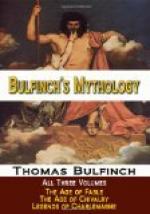Tristram hastened to Gouvernail, his squire, who drew forth the iron, bound up the wound, and gave him immediate ease. Tristram after the tournament kept retired in his tent, but Arthur, with the consent of all the knights of the Round Table, decreed him the honors of the second day. But it was no longer a secret that the victor of the two days was the same individual, and Gouvernail, being questioned, confirmed the suspicions of Launcelot and Arthur that it was no other than Sir Tristram of Leonais, the nephew of the king of Cornwall.
King Arthur, who desired to reward his distinguished valor, and knew that his Uncle Mark had ungratefully banished him, would have eagerly availed himself of the opportunity to attach Tristram to his court,—all the knights of the Round Table declaring with acclamation that it would be impossible to find a more worthy companion. But Tristram had already departed in search of adventures, and the damsel of Queen Isoude returned to her mistress.
CHAPTER XIV
SIR TRISTRAM’S BATTLE WITH SIR LAUNCELOT
Sir Tristram rode through a forest and saw ten men fighting, and one man did battle against nine. So he rode to the knights and cried to them, bidding them cease their battle, for they did themselves great shame, so many knights to fight against one. Then answered the master of the knights (his name was Sir Breuse sans Pitie, who was at that time the most villanous knight living): “Sir knight, what have ye to do to meddle with us? If ye be wise depart on your way as you came, for this knight shall not escape us.” “That were pity,” said Sir Tristram, “that so good a knight should be slain so cowardly; therefore I warn you I will succor him with all my puissance.”




